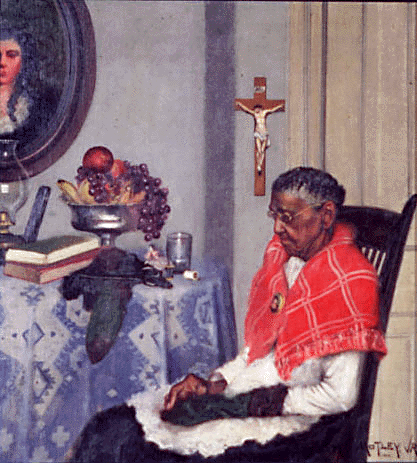| |
Archibald John Motley Jr (October 7, 1891, New Orleans, Louisiana – January 16, 1981, Chicago, Illinois)
A Louisiana Creole painter. He studied painting at the School of the Art Institute of Chicago during the 1910s, graduating in 1918. He is most famous for his colorful chronicling of the African-American experience during the 1920s and 1930s, and is considered one of the major contributors to the HarlemRenaissance.
Unlike many other Harlem Renaissance artists, Archibald Motley, Jr. never lived in Harlem—-he was born in New Orleans and spent the majority of his life in Chicago. His was the only black family in a white, European neighborhood. Though he was offered a scholarship to study architecture, he turned it down in order to study art.
He attended the school of the School of the Art Institute of Chicago where he received classical training but his modernist-realist works were out of step with the school's then-conservative bent. While he was a student, in 1913, other students at the School of the Art Institute of Chicago rioted against the Armory Show, a collection of the best new modern art.
Motley graduated in 1918 and kept his modern, jazz-influenced paintings secret for some years thereafter.Motley experienced success early in his career; in 1927 his piece Mending Socks was voted the most popular exhibit at the Newark Museum in New Jersey. He was awarded the Harmon Foundation award in 1928, and then became the first African-American to have a one-man exhibit in New York City. He sold twenty-two out of the twenty-six exhibitedpaintings.
Skin tone and identity
Motley was highly interested in skin tone, and did numerous portraits documenting women of varying African-American blood quantities ("octoroon," "quadroon," "mulatto"). These portraits celebrate skin tone as something diverse, inclusive, and pluralistic. The also demonstrate an understanding that these categorizations become synonymous with public identity and influence one's opportunities in life. It is often difficult if not impossible to tell what kind of racial mixture the subject has without referring to the title. These physical markers of blackness, then, are unstable and unreliable, and Motley exposed that difference.
experiment with Skin tones ....Source
Motley’s fascination with painting the different types of African Americans stemmed from a desire to give each African American his or her own character and personality. This is consistent with Motley’s aims of portraying an absolutely accurate and transparent representation of African Americans; his commitment to differentiating between skin types shows his meticulous efforts to specify even the slightest differences between individuals. In an interview with the Smithsonian Institution, Motley explained his motives and the difficulty behind painting the different skin tones of African Americans:
“They're not all the same color, they're not all black, they're not all, as they used to say years ago, high yellow, they're not all brown. I try to give each one of them character as individuals. And that's hard to do when you have so many figures to do, putting them all together and still have them have their characteristics” (Motley 1978)
In this excerpt from the interview, Motley describes how each individual he paints has a unique skin tone. By painting the differences in their skin tones, Motley is also attempting to bring out the differences in personality of his subjects.
It could be interpreted that through this differentiating, Motley is asking white viewers not to lump all African Americans into the same category or stereotype, but to get to know each of them as individuals before making any judgments.
|
|
The Octroon
The Octoroon Girl, features a woman who is one-eighth black. In the image a graceful young woman with dark hair, dark eyes and light skin sits on a sofa while leaning against a warm red wall. She wears a black velvet dress with red satin trim, a dark brown hat and a small gold chain with a pendant. In her right hand, she holds a pair of leather gloves.
The woman stares directly at the viewer with a soft, but composed gaze. Her face is serene. Motley balances the painting with a picture frameand the rest of the couch on the left side of the painting.
The Octoroon
In Motley’s paintings, he made little distinction between octoroon women and white women, depicting octoroon women with material representations of status and European features. It appears that the message Motley is sending to his white audience is that even though the octoroon woman is part African American, she clearly does not fit the stereotype of being poor and uneducated.
He requests that white viewers look beyond the genetic indicators of her race and see only the way she acts now—distinguished, poised and with dignity.
In his attempt to deconstruct the stereotype, Motley has essentially removed all traces of the octoroon’s race. The only indicator of her African American descent is the title, which seems almost like an afterthought. If a white viewer were to see this painting without the title, he or she may not even realize that the woman was part African American. Upon viewing the title, Motley hopes then that the audience will see just how unfitting the stereotype is for this refined young woman.
It is also important to consider Motley’s African American audiences. His paintings possess a very prevalent sense of his racial pride, a feeling he hopes African American audiences will relate to and appreciate. It appears that he is saying to African American viewers that although he is not a loud advocate for equal rights, his paintings are his way of making his voice heard
"
More paintings of the Octoroons which Clearly shows his Creole Heritage
|
Interesting links
|
Self Potrait
Bronzeville at Night
In his paintings of jazz culture, Motley often depicted Chicago's Bronzeville neighborhood, which offered a safe haven for blacks migrating from the South. One of his most famous works showing the urban black community is Bronzeville at Night, showing African Americans as actively engaged, urban peoples who identify with the city streets. In the work, Motley provides a central image of the lively street scene and portrays the scene as a distant observer, capturing the many individual interactions but paying attention to the big pictureat the same time.
Like many of his other works, Motley’s cross-section of Bronzeville lacks a central narrative. For example, a brooding man with his hands in his pockets gives a stern look. Behind the bus, a man throws his arms up ecstatically. In the center, a man exchanges words with a partner, his arm up and head titled as if to show that he is making a point. By displaying a balance between specificity and generalization, he allows “the viewer to identify with the figures and the places of the artist’s compositions.”[.
Source Wikipedia.com
Photos..American Art Gallery
|
More of His astounding art
|

|
|

